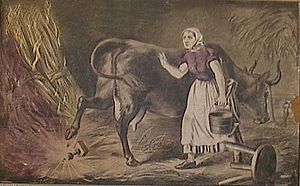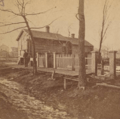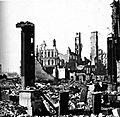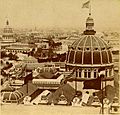Great Chicago Fire facts for kids
Quick facts for kids Great Chicago Fire |
|
|---|---|
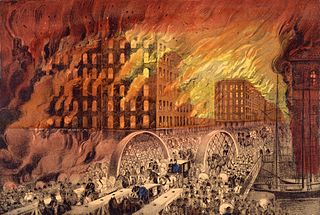
Artist's rendering of the fire, by Currier and Ives; the view faces northeast across the Randolph Street Bridge
|
|
| Location | Chicago, Illinois, United States |
| Statistics | |
| Cost | $222 million (1871 USD) (approx. $4.7 billion in 2020) |
| Date(s) | October 8, 1871 – October 10, 1871 |
| Burned area | 2,112 acres (8.55 km2) |
| Cause | Unknown |
| Buildings destroyed | 17,500 buildings |
| Deaths | 300 (estimate) |
The Great Chicago Fire was a huge fire that burned in Chicago, Illinois, United States. It started on Sunday, October 8, 1871, and lasted for almost three days. This terrible event destroyed a large part of the city. Today, one of the stars on the Chicago flag reminds people of this important fire.
Contents
- When Did the Great Chicago Fire Happen?
- How Did the Fire Start?
- Why Did the Fire Spread So Fast?
- How Did the Fire Spread Through Chicago?
- How Much Damage Did the Fire Cause?
- What Happened After the Fire?
- What Buildings Survived the Fire?
- What Lessons Did People Learn from the Fire?
- How Is the Fire Remembered Today?
- Timeline of the Great Chicago Fire
- Images for kids
- See also
When Did the Great Chicago Fire Happen?
The Great Chicago Fire began on October 8, 1871. It burned for a long time, finally stopping on October 10, 1871. That's nearly 72 hours of fire!
How Did the Fire Start?
No one knows for sure how the fire began. The most famous story says it started in a barn. This barn belonged to the O'Leary family. The story claims that Mrs. O'Leary's cow kicked over a lantern. This supposedly caused the first spark. However, the O'Leary family always said they were not responsible. Many people today believe this story is not true.
Some people think that men were gambling in the barn. They might have accidentally knocked over a lantern. Other ideas suggest the fire was caused by a meteor shower! The true cause of the fire remains a mystery.
Why Did the Fire Spread So Fast?
Even though we don't know how the fire started, we know why it spread quickly:
- Lots of Wood: Most buildings in Chicago were made of wood. Wood catches fire easily and burns very fast.
- Dry Weather: Chicago had not received much rain for a long time. This made everything very dry. Dry conditions help fires spread quickly. From July 4 to October 9, Chicago only got 1 inch (25 mm) of rain.
- Strong Winds: A strong wind blew from the southwest. This wind pushed the fire from one building to the next.
- Fire Whirls: The intense heat created "fire whirls." These were like small tornadoes. They carried burning pieces of wood high into the air. These pieces then landed far away, starting new fires.
How Did the Fire Spread Through Chicago?
The fire began in a neighborhood southwest of the city center. Firefighters were sent to the wrong place at first. This mistake gave the fire more time to grow.
When firefighters finally arrived, the fire was already huge. They hoped the Chicago River would stop the flames. But many lumber yards and warehouses were along the river. These places were full of things that could burn. So, the fire easily jumped across the river.
The fire then moved into the heart of the city. People began to panic. The mayor, Roswell B. Mason, asked nearby towns for help. The fire even burned down the courthouse. The big bell in the courthouse tower crashed to the ground.
The fire jumped the river a second time. It started burning on the city's north side. Then, the city's waterworks caught fire. This building was destroyed. This meant firefighters had no water to put out the fire!
Finally, late on the evening of October 9, it started to rain. The rain helped to put out the fire. But by then, a large part of the city was already destroyed.
How Much Damage Did the Fire Cause?
The Great Chicago Fire caused a lot of damage:
- About 300 people died in the fire. It was hard to count everyone.
- The fire destroyed over 17,000 buildings. These included homes, businesses, and important places like the courthouse.
- More than 100,000 people lost their homes.
- The fire caused $222 million in property damage. This would be billions of dollars today!
- The fire burned an area of about 3.3 square miles (9 square kilometers).
What Happened After the Fire?
Even though the fire caused huge damage, the people of Chicago did not give up. They started to rebuild the city right away.
People from all over the country helped. Even people from other countries sent aid. They sent money, food, clothing, and other supplies. To keep order, the city was under martial law for two weeks. General Philip H. Sheridan was in charge. He used soldiers to protect the city from looting.
The city government made new rules for building. These rules made sure that buildings were safer. They were designed to be less likely to catch fire.
The United Kingdom donated books to help start a free public library in Chicago. This was a great way to help people learn and rebuild their lives.
Business owners and land buyers quickly started rebuilding. The first load of lumber for rebuilding arrived the day the last burning building was put out.
What Buildings Survived the Fire?
Most of the city was destroyed. But a few buildings survived the fire:
- St. Michael's Church: This church was damaged. But its outside walls survived. The church was later rebuilt.
- Chicago Water Tower: This tower was also damaged. But it survived and is still standing today.
- Chicago Avenue Pumping Station: This building was next to the Water Tower. It also survived the fire.
- Police Constable Bellinger's cottage
- 2323 and 2339 North Cleveland Avenue
- St. James Cathedral: The bell tower of this cathedral survived. It was used in the rebuilt church.
What Lessons Did People Learn from the Fire?
The Great Chicago Fire taught people important lessons:
- Build Safer Buildings: People learned to build buildings that are less likely to catch fire.
- Have a Good Fire Department: People realized the importance of a well-trained fire department. It also needed good equipment.
- Help Each Other: People learned how important it is to help each other during hard times.
How Is the Fire Remembered Today?
The Great Chicago Fire is still remembered in many ways:
- The Chicago Fire Academy trains firefighters. It is built where the O'Leary's barn used to be.
- A sculpture called "Pillar of Fire" stands where the fire is thought to have started.
- One of the stars on the flag of Chicago represents the Great Chicago Fire.
- Chicago has a professional soccer team called the Chicago Fire.
- Many books and movies tell the story of the Great Chicago Fire.
Timeline of the Great Chicago Fire
- October 8, 1871: A fire begins around 9:00 p.m. near a small farm on 137 DeKoven St.
- October 9, 1871: The fires continue to burn.
- October 10, 1871: The fires are finally put out in the early morning. President Grant orders donations to be sent to the city.
- October 11, 1871: A story that the O’Leary cow caused the fire spreads. The city of Chicago is placed under martial law.
- October 12, 1871: Businesses are able to partly open again.
- October 17, 1871: Temporary homes are built. But 100,000 people are still without homes.
- October 19, 1871: A writer largely discredits the Catherine O’Leary story.
- November 11, 1871: The police and fire commissioner begin an investigation into Ms. O’Leary.
Images for kids
-
Artist's rendering of the fire, by Currier and Ives; the view faces northeast across the Randolph Street Bridge
-
General Philip H. Sheridan
-
1871 illustration from Harper's Magazine depicting Mrs. O'Leary milking the cow
See also
 In Spanish: Gran incendio de Chicago para niños
In Spanish: Gran incendio de Chicago para niños


